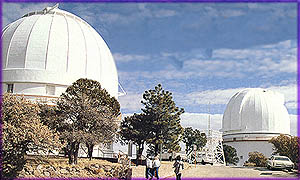General-
 Established and grew under
protection of U.S. Army post of the same name that was
founded in 1854 at crossroads of famous Chihuahua Trail
and Butterfield Overland Mail Route. Has served as county
seat of Presidio County and later Jeff Davis County
created largely from Presidio. Altitude and climate make
it popular tourist and camping area. During, seasons
hunters seek plentiful mule deer and pronghorn antelope. Established and grew under
protection of U.S. Army post of the same name that was
founded in 1854 at crossroads of famous Chihuahua Trail
and Butterfield Overland Mail Route. Has served as county
seat of Presidio County and later Jeff Davis County
created largely from Presidio. Altitude and climate make
it popular tourist and camping area. During, seasons
hunters seek plentiful mule deer and pronghorn antelope.
Chihuahuan
Desert Visitor
Center-Botanical
gardens, and nature trails related to the desert flora.
Open May - Aug. Mon. - Fri. I - 5 p.m., Sat., Sun. 9 a.m.
- 5 p.m. On Texas 118, 3.5 mi. south.
Davis
Mountains State Park-
In a
sloping basin among scenic Davis Mountains, 1,869 acres
host more than 155,000 visitors annually. Primary service
facility is multilevel hotel called Indian Lodge,
patterned in the pueblo style. A free interpretive center
is open afternoons, June through Aug., featuring plant
and animal material, both live and mounted; bird
observation window and wildlife watering station.
Camping, picnicking, dining room, trailer facilities,
rest rooms, nature study, hiking. Six miles west of Fort
Davis; Texas 118, Park Road 3. Admission.
Fort
Davis National Historic Site-
When pioneers and
gold seekers surged west in the mid - 1800's, national
concern focused on secure travel routes. In Texas, nearly
600 miles of wilderness stretched between San
Antonio
and El Paso. Throughout the distance,
wagon travelers fell prey to fiercely hostile Indians.
Fort Davis, established in 1854, was the first military
post to guard the route and offer haven by the precious
waters of Limpia Creek.
But the trauma of
Civil War stripped the frontier of military protection,
and Indians again raided unchecked. Little of value
remained when federal troops returned to Fort Davis in
1867. New construction eventually produced substantial
rock and adobe buildings that housed up to 12 companies
of cavalry and infantry. Post-war troopers were black
"buffalo soldiers," many of them former slaves
from Southern plantations.
As the western
movement resumed, troopers patrolled the long immigrant
road, escorted mail and wagon trains, and mounted
wide-ranging expeditions into the vast wilderness
territory. After years of conflict, peace and civilian
settlement finally came to the frontier, With the
bluecoats no longer needed, Fort Davis was deactivated in
1891.
Operated by the
National Park Service, Fort Davis today is a superb
example of frontier forts from that epic era, including
both ruins and restorations. A museum, open daily in
reconstructed barracks, vividly interprets frontier
military life.
Another feature is
a sound re-creation of a 19th-Century military
parade-bugles and hoofbeats ... the clank and jangle of
mounted troops music from band manuals of 1875. Echoing
over the empty parade ground, it is a haunting fragment
of the past.
Open daily 8 a.m.
- 5 p.m. except national holidays; admission.
Historic
Inn: Limpia Hotel-
Restored country
inn, c. 1912; sturdy, turnof-the-century oak furniture,
second-story veranda and glassed-in sun porch with rattan
rockers; Boarding House restaurant. Two suites and nine
rooms with baths.
Neill
Museum-
Antique toys made
in Texas, 300 antique dolls, bottles, and furniture. In
historic 1898 Truehart House seven blocks west of
courthouse. Museum open June - Labor Day daily 10 a.m. -
5 p.m.; admission. Also two rooms bed-and-breakfast with
antique furniture; year round. (432)
426-3969
and 426-3838.
Overland
Trail Museum-
Named for historic
trail that once passed its front door, small museum was
former home, office and shop of Nick Mersfelter, early
resident who was justice of the peace, barber, and area
music master. Austrian-bom Mersfelter could play almost
any instrument, was once member of San Antonio
Philharmonic Orchestra. Pioneer ranch, trail, and law
enforcement artifacts. Open Wed. - Sun. afternoons in
summer; admission.
Scenic
Drive-
A 74-mile
loop through the Davis Mountains (from and back to Fort
Davis) leads to a host of choice mountain landscapes. Two
miles south on Texas 17 take Texas 166 west to
intersection with Texas 118, then southeast back to Texas
17 and Fort Davis. Features include nine scenic roadside
parks, Mount Locke topped by McDonald Observatory,
beautiful Madera Canyon, and Davis Mountains State Park.
University
of Texas McDonald Observatory at Mount Locke-
Built 1932
following bequest from William J. McDonald, amateur
astronomer. On a 6,791-foot peak of Mount Locke. Site
selected because of clear air, high ratio of cloudless
nights, distance from concentrations of artificial
lights, and dust and radiation-filtering growths of
shrubs and timber. Original instrument was 82-inch
reflector; 107-inch reflector is in larger dome.
A visitor center
at the foot of Mount Locke presents programs daily 9 a.m.
- 5 p.m. In summer, solar viewing presented II a.m. and
3:30 p.m.; guided tours at 9:30 a.m. and 2 p.m. Winter:
solar viewing 11 a.m., guided tour 2 p.m. Up on the
summit, the larger dome is open to public and may be
viewed from visitors' gallery. Each Tues., Fri. and Sat.
evening, weather permitting, the center conducts
"Star Parties" for the general public, with
viewing of stars and planets through telescopes set up by
the observatory. Observatory is 16 miles northwest via
Texas 118, Spur 78, Spectacular view from site.
Once a month,
visitors can view celestial objects through 107-inch
telescope by making reservation with visitor center.
(Very popular and sometimes booked months in advance.)
Fee charged for large telescope viewing, (432)
426-3640. |


